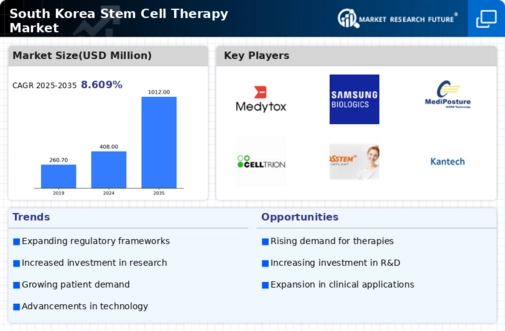Regulatory Framework Enhancements
The regulatory landscape for the stem cell-therapy market in South Korea is evolving, with enhancements aimed at facilitating research and commercialization. The government has implemented streamlined approval processes for clinical trials, which is likely to accelerate the development of new therapies. Recent reforms have reduced the time required for regulatory approvals by approximately 30%, making it easier for companies to bring innovative treatments to market. Additionally, the establishment of clear guidelines for the ethical use of stem cells is fostering a more transparent environment for researchers and practitioners. These regulatory improvements are expected to boost investor confidence and encourage more companies to enter the stem cell-therapy market, ultimately leading to a wider array of treatment options for patients.
Growing Investment in Biotech Sector
Investment in the biotech sector is a crucial driver for the stem cell-therapy market in South Korea. The government has been actively promoting biotechnology as a key industry, allocating substantial funding to research and development initiatives. In 2025, the South Korean government announced a budget increase of 20% for biotech research, which includes stem cell therapies. This financial support is likely to attract private investors and venture capitalists, fostering innovation and accelerating the commercialization of new therapies. Furthermore, partnerships between academic institutions and biotech firms are becoming more prevalent, enhancing the research landscape. As a result, the stem cell-therapy market is expected to benefit from a robust pipeline of new products and therapies, ultimately improving patient outcomes.
Aging Population and Associated Health Issues
The demographic shift towards an aging population in South Korea is significantly impacting the stem cell-therapy market. As the population ages, there is an increasing prevalence of age-related diseases such as neurodegenerative disorders, cardiovascular diseases, and orthopedic conditions. This demographic trend is driving demand for innovative treatment options, including stem cell therapies, which offer potential solutions for these complex health issues. According to recent statistics, the proportion of individuals aged 65 and older is projected to reach 20% by 2030. This growing patient population is likely to propel the stem cell-therapy market, as healthcare providers seek effective therapies to address the unique challenges posed by aging. Consequently, the market is poised for substantial growth in the coming years.
Technological Advancements in Stem Cell Research
The stem cell-therapy market in South Korea is experiencing a surge due to rapid technological advancements in research methodologies. Innovations such as CRISPR gene editing and improved cell culture techniques are enhancing the efficacy of stem cell therapies. These advancements are not only increasing the success rates of treatments but also expanding the range of conditions that can be addressed. For instance, the development of induced pluripotent stem cells (iPSCs) has opened new avenues for regenerative medicine. As a result, the market is projected to grow at a CAGR of approximately 15% over the next five years, driven by these technological breakthroughs. The integration of artificial intelligence in research processes further streamlines the development of new therapies, making the stem cell-therapy market increasingly competitive and dynamic.
Rising Awareness and Acceptance of Stem Cell Treatments
Public awareness and acceptance of stem cell treatments are crucial factors influencing the stem cell-therapy market in South Korea. Educational campaigns and outreach programs have been instrumental in informing the public about the potential benefits and applications of stem cell therapies. As awareness increases, patients are more likely to seek out these innovative treatments, leading to higher demand. Surveys indicate that approximately 70% of the population is now aware of stem cell therapies and their potential to treat various conditions. This shift in perception is likely to encourage healthcare providers to incorporate stem cell therapies into their treatment protocols, further driving market growth. The increasing acceptance of these therapies is expected to create a more favorable environment for research and development in the stem cell-therapy market.


















Leave a Comment